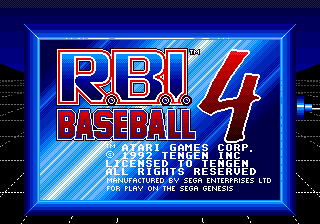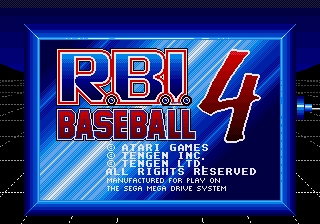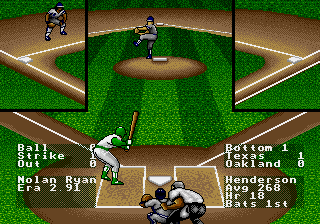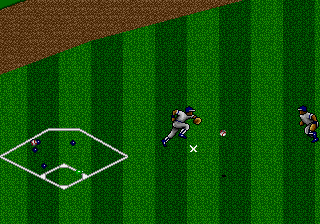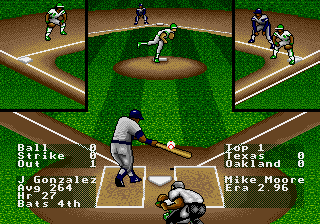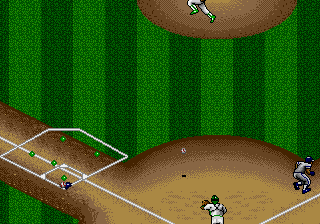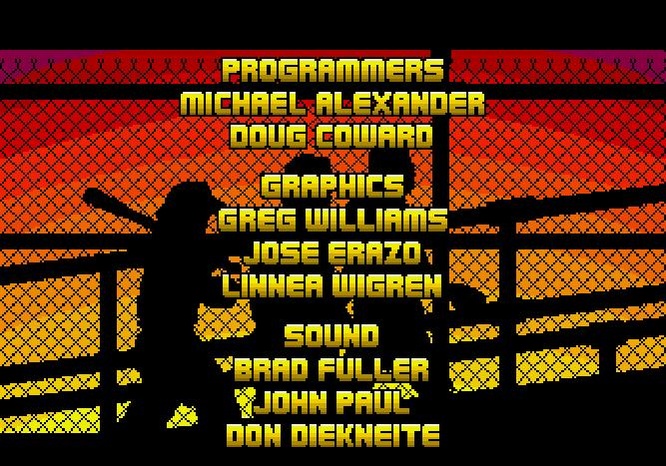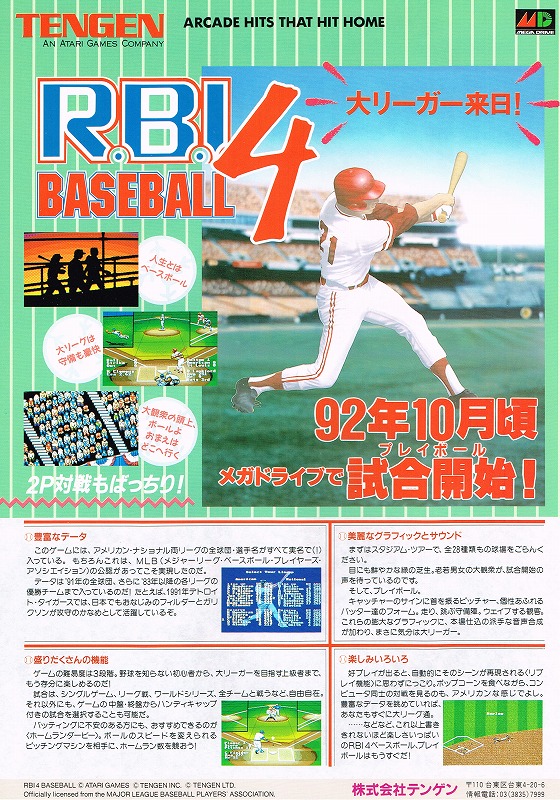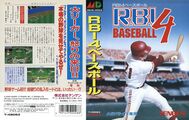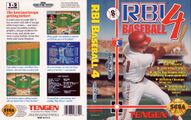R.B.I. Baseball 4
From Sega Retro
| ||||||||||||||||||||
| R.B.I. Baseball 4 | ||||||||||||||||||||
|---|---|---|---|---|---|---|---|---|---|---|---|---|---|---|---|---|---|---|---|---|
| System(s): Sega Mega Drive | ||||||||||||||||||||
| Publisher: Tengen | ||||||||||||||||||||
| Developer: Tengen | ||||||||||||||||||||
| Distributor: Samsung (KR) | ||||||||||||||||||||
| Licensor: Atari Games, Major League Baseball Players Association | ||||||||||||||||||||
| Sound driver: Lisa's Sound Driver[1] | ||||||||||||||||||||
| Genre: Sports[2] (baseball) | ||||||||||||||||||||
| Number of players: 1-2 | ||||||||||||||||||||
| Official in-game languages: | ||||||||||||||||||||
|
R.B.I. Baseball 4 or R.B.I. 4 Baseball (R.B.I.4.ベースボール) is a 1992 baseball game for the Sega Mega Drive by Tengen and the sequel to R.B.I. Baseball 3. It was followed by R.B.I. Baseball '93.
A Sega Mega-CD version was announced[7], but cancelled for unknown reasons.
Contents
Gameplay
The game is a Major League Baseball game including the 26 teams of the 1991 MLB season. The game carries a Major League Baseball Players Association license, so it contains all of the Major League Baseball players but not the team names or logos. Teams have had their stadiums recreated for the game, which include details such as the fountains at Royals Stadium (Kansas City) and the asymmetric outfield of Yankee Stadium (New York). The Japanese version also uses MLB teams (rather than Nippon Professional Baseball teams) and can be played in English or Japanese. Other changes from the previous entry are redrawn player graphics with smoother animation, improved spoken commentary, updated statistics, new game modes (Home Run Derby and Game Breakers), and more historical teams.
Modes
The game has the following modes:
- Play Ball: A nine-inning exhibition game between any two teams from either league (which can be the same team) or a series. The selectable series are Best of Seven (play any team in a best of seven playoff series), Play Division (play against every team in the 1991 American League, 1991 National League, American division winners, or National division winners), or Play All Teams (play against every team in the game). Series games use a password system for continuing.
- Home Run Derby: Players choose a team, a batter, and a pitch speed (60, 70, 80, 90, or 100). Each player gets 20 pitches and tries to hit as many home runs as possible. In two-player games, the stadium used belongs to player one's team. Awards are given for 3 (bronze), 5 (silver), 8 (gold), or 11 or more (grand prize) runs.
- Game Breakers: Players choose a team. Rather than starting a new game, players choose from a list of 17 situations, such as starting the eight inning down nine points, starting the ninth inning with neither team having any points, or being in the bottom of the eighth inning ahead one point but with the opposing team having bases loaded and no outs. After choosing a situation, players choose a relief pitcher and finish the game with the selected premise. A password is given after each completed game.
- Stadium Tour: An overhead view of any of the 28 ballparks in the game (one for every team, plus an American League and a National League stadium).
- View Teams: View all of the team rosters and statistics for any player.
Games can be played as Human vs. Comp (single-player, where the player is the visiting team and bats first), Human vs. Human (two-player game, where player two as the home team), or Comp vs. Comp (two computer-controlled teams play each other, which can be overridden by either control pad to take over play or make substitutions). Before each game, players choose any team and set the batting line-up and choose starting and relief pitchers. A pitcher can only start every other game in a series.
Players can choose from three difficulty levels for computer-controlled opponents (Easy, Medium, and Hard).
Teams
Current
The game includes all 26 teams from the 1991 MLB season, with their stadiums.
| League | Division | Team | Based on |
|---|---|---|---|
| American | West | California | California Angels |
| Chicago | Chicago White Sox | ||
| Kansas City | Kansas City Royals | ||
| Minnesota | Minnesota Twins | ||
| Oakland | Oakland Athletics | ||
| Seattle | Seattle Mariners | ||
| Texas | Texas Rangers | ||
| East | Baltimore | Baltimore Orioles | |
| Boston | Boston Red Sox | ||
| Cleveland | Cleveland Indians | ||
| Detroit | Detroit Tigers | ||
| Milwaukee | Milwaukee Brewers | ||
| New York | New York Yankees | ||
| Toronto | Toronto Blue Jays | ||
| National | West | Atlanta | Atlanta Braves |
| Cincinnati | Cincinnati Reds | ||
| Houston | Houston Astros | ||
| Los Angeles | Los Angeles Dodgers | ||
| San Diego | San Diego Padres | ||
| San Francisco | San Francisco Giants | ||
| East | Chicago | Chicago Cubs | |
| Montreal | Montreal Expos | ||
| New York | New York Mets | ||
| Philadelphia | Philadelphia Phillies | ||
| Pittsburgh | Pittsburgh Pirates | ||
| St. Louis | St. Louis Cardinals |
Previous
In addition, the game includes historical rosters of every division-winning team going back to 1983.
| League | Year | West | East | ||
|---|---|---|---|---|---|
| Team | Based on | Team | Based on | ||
| American | 1990 | Oakland | Oakland Athletics | Boston | Boston Red Sox |
| 1989 | Oakland | Oakland Athletics | Toronto | Toronto Blue Jays | |
| 1988 | Oakland | Oakland Athletics | Boston | Boston Red Sox | |
| 1987 | Minnesota | Minnesota Twins | Detroit | Detroit Tigers | |
| 1986 | California | California Angels | Boston | Boston Red Sox | |
| 1985 | Kansas City | Kansas City Royals | Toronto | Toronto Blue Jays | |
| 1984 | Kansas City | Kansas City Royals | Detroit | Detroit Tigers | |
| 1983 | Chicago | Chicago White Sox | Baltimore | Baltimore Orioles | |
| National | 1990 | Cincinnati | Cincinnati Reds | Pittsburgh | Pittsburgh Pirates |
| 1989 | San Francisco | San Francisco Giants | Chicago | Chicago Cubs | |
| 1988 | Los Angeles | Los Angeles Dodgers | New York | New York Mets | |
| 1987 | San Francisco | San Francisco Giants | St. Louis | St. Louis Cardinals | |
| 1986 | Houston | Houston Astros | New York | New York Mets | |
| 1985 | Los Angeles | Los Angeles Dodgers | St. Louis | St. Louis Cardinals | |
| 1984 | San Diego | San Diego Padres | Chicago | Chicago Cubs | |
| 1983 | Los Angeles | Los Angeles Dodgers | Philadelphia | Philadelphia Phillies | |
All-Star
Finally, the game includes All-Star teams for each league going back to 1989.
| League | Team |
|---|---|
| American | 1991 American League All-Stars |
| 1990 American League All-Stars | |
| 1989 American League All-Stars | |
| National | 1991 National League All-Stars |
| 1990 National League All-Stars | |
| 1989 National League All-Stars |
Production credits
- Programmers: Michael Alexander, Doug Coward
- Graphics: Greg Williams, Jose Erazo, Linnea Wigren
- Sound: Brad Fuller, John Paul, Don Diekneite
- Special Thanks: Michael Klug
Magazine articles
- Main article: R.B.I. Baseball 4/Magazine articles.
Promotional material
also published in:
- Sega Visions (US) #9: "August/September 1992" (1992-xx-xx)[9]
- Electronic Gaming Monthly (US) #39: "October 1992" (1992-xx-xx)[10]
also published in:
- Electronic Gaming Monthly (US) #41: "December 1992" (1992-xx-xx)[11]
- Game Informer (US) #8: "January/February 1993" (199x-xx-xx)[12]
- Electronic Games (1992-1995) (US) #5: "February 1993" (1993-01-12)[13]
- Sega Visions (US) #11: "February/March 1993" (199x-xx-xx)[14]
Physical scans
| Sega Retro Average | ||||||||||||||||||||||||||||||||||||||||||||||||||||||||||||||||||||||||||||||||||||||||||||||||||||||||||||||||||
|---|---|---|---|---|---|---|---|---|---|---|---|---|---|---|---|---|---|---|---|---|---|---|---|---|---|---|---|---|---|---|---|---|---|---|---|---|---|---|---|---|---|---|---|---|---|---|---|---|---|---|---|---|---|---|---|---|---|---|---|---|---|---|---|---|---|---|---|---|---|---|---|---|---|---|---|---|---|---|---|---|---|---|---|---|---|---|---|---|---|---|---|---|---|---|---|---|---|---|---|---|---|---|---|---|---|---|---|---|---|---|---|---|---|---|
|
| 72 | |
|---|---|
| Based on 22 reviews | |
Technical information
- Main article: R.B.I. Baseball 4/Technical information.
References
- ↑ http://vgmpf.com/Wiki/index.php?title=LSD_(GEN_Driver)
- ↑ 2.0 2.1 https://sega.jp/history/hard/megadrive/software_l.html (Wayback Machine: 2020-07-02 23:21)
- ↑ Beep! MegaDrive, "January 1993" (JP; 1992-12-08), page 22
- ↑ GamePro, "September 1992" (US; 1992-xx-xx), page 139
- ↑ 5.0 5.1 5.2 GamePro, "October 1992" (US; 1992-xx-xx), page 50
- ↑ 6.0 6.1 VideoGames & Computer Entertainment, "November 1992" (US; 1992-1x-xx), page 62
- ↑ Mega Play, "August 1992" (US; 1992-0x-xx), page 33
- ↑ File:R.B.I. Baseball 4 MD credits.pdf
- ↑ Sega Visions, "August/September 1992" (US; 1992-xx-xx), page 25
- ↑ Electronic Gaming Monthly, "October 1992" (US; 1992-xx-xx), page 75
- ↑ Electronic Gaming Monthly, "December 1992" (US; 1992-xx-xx), page 99
- ↑ Game Informer, "January/February 1993" (US; 199x-xx-xx), page 68
- ↑ Electronic Games (1992-1995), "February 1993" (US; 1993-01-12), page 34
- ↑ Sega Visions, "February/March 1993" (US; 199x-xx-xx), page 65
- ↑ 1700 igr dlya Sega, "" (RU; 2001-xx-xx), page 185
- ↑ Beep! MegaDrive, "January 1993" (JP; 1992-12-08), page 30
- ↑ Electronic Gaming Monthly, "October 1992" (US; 1992-xx-xx), page 30
- ↑ Game Mania, "May 1993" (UK; 1993-xx-xx), page 80
- ↑ Hippon Super, "November 1992" (JP; 1992-10-03), page 47
- ↑ Joypad, "Novembre 1992" (FR; 1992-1x-xx), page 62
- ↑ Joystick, "Novembre 1992" (FR; 1992-1x-xx), page 172
- ↑ Sega Mega Drive Advanced Gaming, "December 1992" (UK; 1992-xx-xx), page 28
- ↑ Sega Mega Drive Advanced Gaming, "January 1993" (UK; 199x-xx-xx), page 94
- ↑ Mega Drive Fan, "March 1993" (JP; 1993-02-xx), page 59
- ↑ Mega, "December 1992" (UK; 1992-11-19), page 60
- ↑ MegaTech, "November 1992" (UK; 1992-10-20), page 24
- ↑ Marukatsu Mega Drive, "November 1992" (JP; 1992-10-xx), page 109
- ↑ Sega Power, "January 1993" (UK; 1992-12-03), page 51
- ↑ Sega Pro, "December 1992" (UK; 1992-11-12), page 62
- ↑ Sega Pro, "April 1993" (UK; 1993-03-11), page 67
- ↑ Sega Zone, "July 1994" (UK; 1994-06-xx), page 36
- ↑ Sega Force, "February 1993" (UK; 1993-01-14), page 76
- ↑ Sega Saturn Magazine, "September 1995" (JP; 1995-08-08), page 86
- ↑ Tricks 16 bit, "Tricks Sega Gold 800 igr" (RU; 1998-03-20), page 207
| R.B.I. Baseball 4 | |
|---|---|
|
Main page | Hidden content | Magazine articles | Reception | Region coding | Technical information
Prototypes: 1991-08
| |
| R.B.I. Baseball games for Sega systems | |
|---|---|
| R.B.I. Baseball 3 (1991) | R.B.I. Baseball 4 (1992) | R.B.I. Baseball '93 (1993) | R.B.I. Baseball '94 (1994) | R.B.I. Baseball '95 (unreleased) | RBI Baseball '95 (1995) | |
